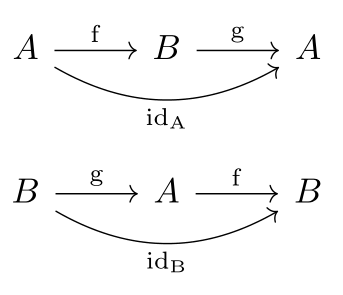Injectivity and surjectivity
Injective
A function \( f : A \to B \) is injective iff
Injections are often denoted like [\( A \quad ? \quad B \)].
Surjective
A function \( f : A \to B \) is surjective iff
Surjections are often denoted like [\( A \quad ? \quad B \)].
Bijective
A function \( f \) that is both injective and surjective is said to be bijective. A bijective function is called a bijection or a one-to-one correspondence or an isomorphism of sets; it is is often denoted like \( f : A \xrightarrow{\sim} B \).
If there is a bijection between sets \( A \) and \( B \), then each element \( a \) of \( A \) can be matched with exactly one element \( b \) of \( B \). \( A \) and \( B \) are said to be [...]. The statement that \( A \) and \( B \) have such a relationship is often denoted as \( A \cong B \).
From the perspective of inverses
If \( f : A \to B \) is a bijection, it can be 'flipped' to define a function \( g : B \to A \). This is a flipping of \( \Gamma_f \), the graph of \( f \), along it's diagonal. \( f \) being a bijection insures that such a flipping action produces a valid function. The function \( g \) has two interesting properties:
These properties correspond to the statement that the following two diagrams compute:

Bijections have inverses
The first identity above states that \( g \) is a [...]-inverse of \( f \). The second identity states that \( g \) is a [...]-inverse of \( f \). Combined we say that \( g \) is the inverse of \( f \), and denote it as [...]. Thus, bijections have inverses.
If a function has an inverse, is it a bijection?
This is [true or false?]. We can, in fact, break this statement into two pieces.
Let \( A \) and \( B \) be sets, with \( A \neq \emptyset \), and let \( f : A \to B \) be a function. Then the following bi-implications hold:
- \( f \) has a left-inverse if and only if it is [...].
- \( f \) has a right-inverse if and only if it is [...].
Can you think of the proof of these two bi-implications?
Futhermore, if \( f \) has a left-inverse \( g_l \) and right-inverse \( g_r \), then these inverses must be the same function! This can be shown by considering:
TODO: add diagram
